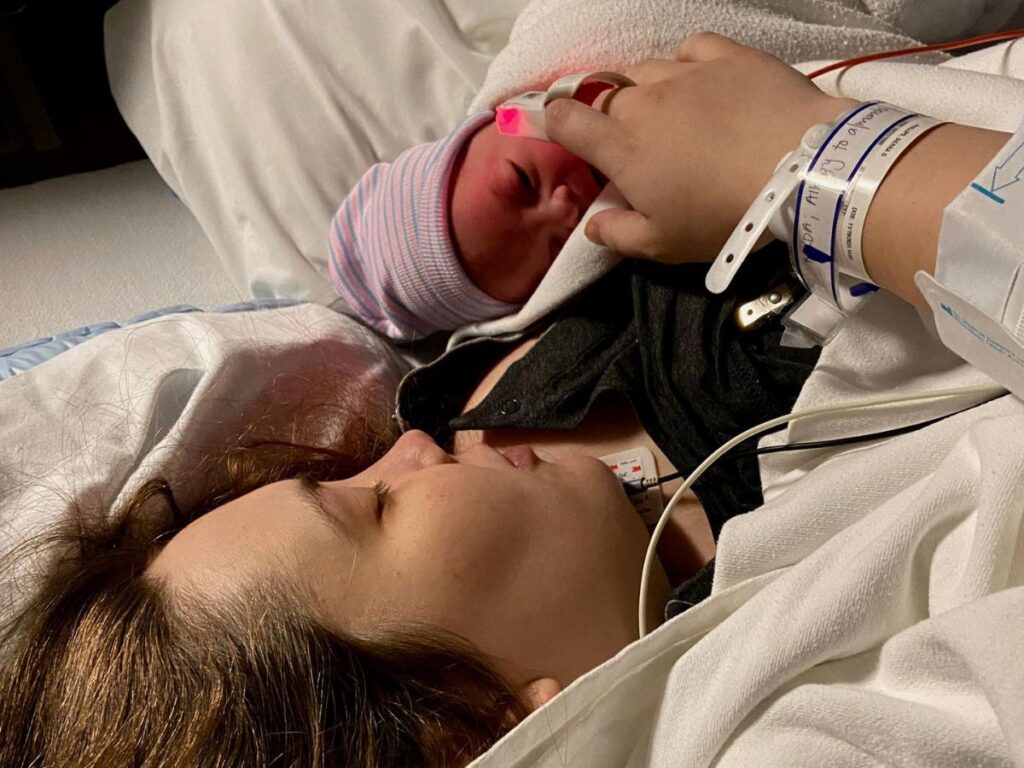Written by Sierra Phillips, guest contributor for Let’s Talk Babywearing
We all love the idea of carrying our sweet little newborn close to us—snuggled up, warm, calm, and easy to soothe. It’s practical, bonding, beautiful… but it’s not something to rush into right after surgery. I learned this through experience, and I want to share everything I wish I had known from the beginning.
Delay Babywearing for 6–8 Weeks (or Until Doctor Approved)
People like to talk about c-sections like they aren’t a major surgery performed to a woman’s abdomen. Her abdominal muscles are literally separated during surgery. If your nurses were anything like mine, they expected you to be up and walking within three days, and you are expected to be able to care for a newborn within a few hours of waking from a massive abdominal surgery.
You don’t want to delay your healing because you decided to baby wear too soon. I baby wore too soon and could’ve come out with multiple long-term health issues such as: delayed incision healing, infection, friction on the incision, increased scarring, pelvic floor dysfunction (hello bladder leakage), back and core injury, increased pain and discomfort, fatigue, and overexertion. I got lucky. Learn from my mistakes and make sure you are cleared from your doctor before you baby wear.
So many of these things can sneak up on you slowly if you’re not careful—and suddenly you’re paying the price months later. You have enough on your plate. Don’t let babywearing be what slows down your recovery.
When to Know You’re Ready to Babywear After a C-Section
Here’s the thing: even if you feel ready, you may not be. Some people regain mobility quickly, others take longer—but the only way to truly know it’s safe is to talk to your doctor or midwife. They can help you assess whether your healing is far enough along to begin carrying again.
Here are some general signs that you might be ready:
- Your incision is healing well (no signs of infection or bleeding).
- You have little to no pain when moving around.
- Your core mobility has mostly returned.
- Your posture has improved and doesn’t feel unstable.
Once you’ve been cleared medically, start small. Use soft, stretchy wraps or a ring sling that won’t put pressure on your lower abdomen. Stick to short wear sessions and slowly build up over time. Keep baby high on your chest (close enough to kiss!) in the newborn hold. Nothing—I mean nothing—should touch your incision.
If you notice increased pain, swelling, bleeding, or fatigue, back off. It’s not a setback. It’s your body saying, “Not yet.”
What Happens When You Babywear Too Early
Let me be honest: I tried to babywear at 4–5 weeks post-op. I was overtired, overwhelmed, and grieving the loss of the birth experience I had hoped for. My baby had reflux and I was desperate to soothe him—and to feel like I had some control. I thought, “Well, I can go to the bathroom by myself now, so I must be fine.” (Spoiler alert: I was not fine.)
I was still heavily medicated for pain, which masked any warning signs my body tried to give me. At the time, it felt okay. But I set myself up for a longer core healing journey. I’m lucky I didn’t do more damage.
Please don’t make the same mistake. Just because you can doesn’t mean you should.
Babywearing with a (Mostly) Healed Incision
Even with a healed incision, babywearing isn’t always painless. If your baby is anything like mine, then from the moment they were laid on your chest, those tiny toes were digging right into your incision. And somehow, they never stop! My son always finds a way to push right into my scar—even now, 8 months later.
Sometimes, that bruised, tender feeling never completely goes away. I’ve learned to adjust the carrier and engage my abs to avoid that downward pressure that can make things worse. That said, my back and shoulders took a hit from overcompensating for my weak core. Eventually though, with rest and patience, babywearing actually helped me rebuild strength, get outside, and start to feel like me again.
Find Carriers That Fit Your New Body
Your postpartum body isn’t the same, and your carrier needs to support that. In those early months, light wraps were great because they didn’t put any pressure on my abdomen. But once my son outgrew the wrap stage (around 3 months), I needed something sturdier.
I found that heavily padded carriers with lumbar support—like the Líllébaby or the Wildbird Aerial—were the most comfortable for my short torso and weak core. But then, surprisingly, once I’d healed more (around 6 months postpartum), I ditched the bulk and preferred simpler carriers like the Happy Baby. Just an apron-style wrap—no thick foam waistbands—was enough and actually felt better.
Your preferences will shift. Your needs will change. Don’t give up. There is a baby carrier that works for you, even if it’s not the one you expected.
Final Thoughts: Listen to Your Body
Here’s the bottom line: don’t wear early, even if you think you’re ready. Always get cleared by your doctor or midwife. When you do begin, take it slow and watch for the signs your body gives you. Pain, pressure, swelling, exhaustion—none of those are worth pushing through.
Babywearing can be such a beautiful part of your healing process if used safely and gradually. It helped me reconnect to my body, bond with my baby, and find freedom again—but only when I gave my body the time it truly needed.
And remember: if one carrier isn’t working, try another. Make it work for you. Because your body deserves support too.

